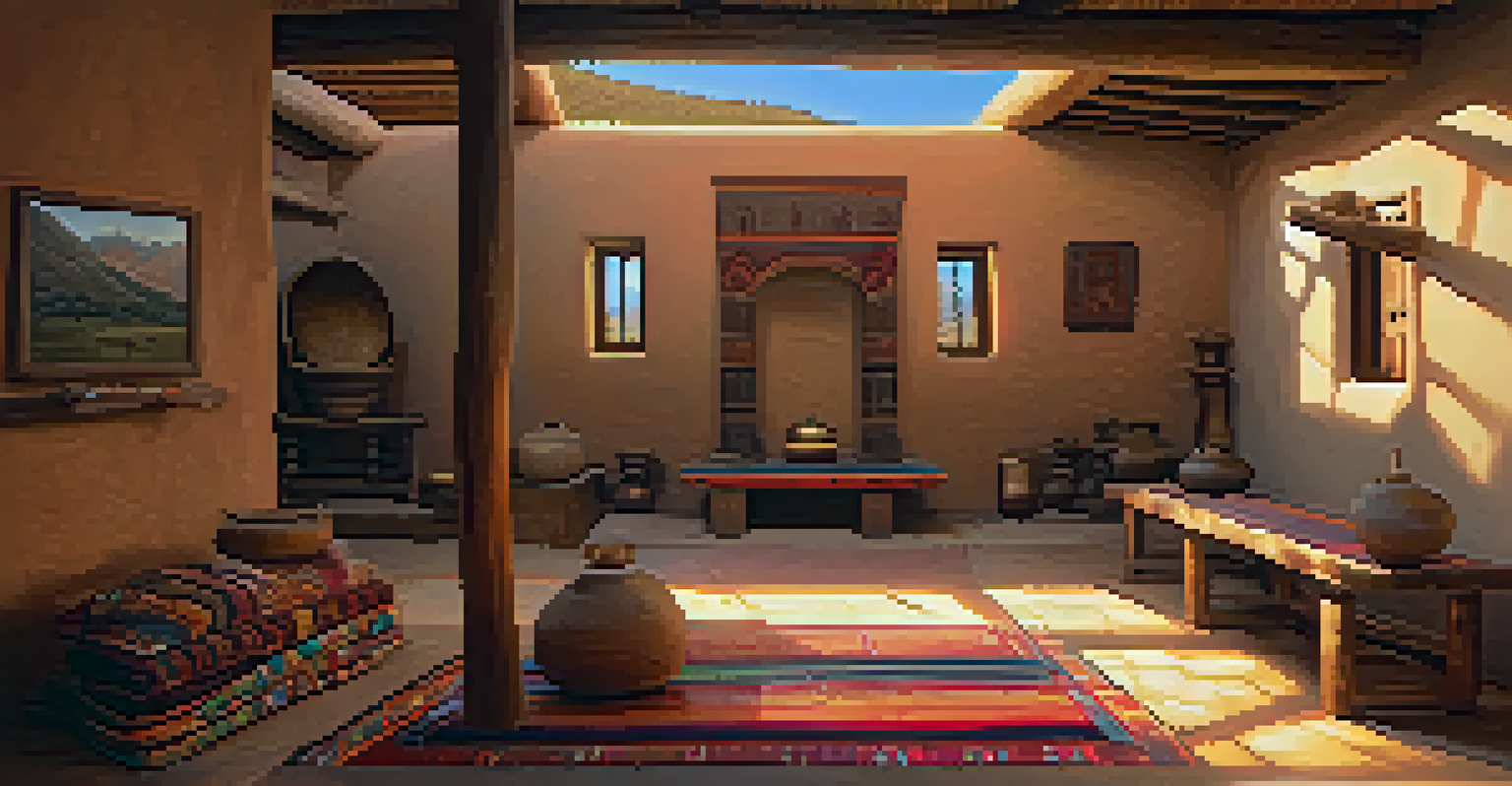Traditional Andean Architecture: Techniques and Materials Used

The Rich History of Traditional Andean Architecture
Traditional Andean architecture is steeped in a rich cultural history that dates back thousands of years. It reflects the ingenuity of pre-Columbian civilizations who adapted to the diverse Andean landscape. From the Inca Empire to modern indigenous communities, this architectural style showcases a blend of functional design and spiritual significance.
Architecture is the learned game, correct and magnificent, of forms assembled in the light.
The unique environment of the Andes, characterized by high altitudes and varying climates, has shaped the architectural techniques used by these cultures. The structures built by these communities are not just homes; they are a testament to their connection with nature and their ancestors. This historical context provides a fascinating backdrop for understanding the evolution of Andean architecture.
By examining the past, we can gain insight into how traditional Andean architecture has influenced contemporary designs. Many modern architects draw inspiration from these ancient techniques, demonstrating the enduring value of this architectural heritage.
Key Materials in Andean Architecture
Andean architecture is notable for its use of locally sourced materials that blend seamlessly with the environment. Stone is perhaps the most iconic material, used in everything from Incan temples to rural homes. The ability of stone to withstand the elements makes it a reliable choice for construction in the often harsh Andean climate.

In addition to stone, adobe—a natural building material made from clay, sand, and straw—plays a significant role in Andean architecture. Adobe structures provide excellent insulation, keeping homes cool in the daytime and warm at night. This sustainable material is not only economical but also reflects the region's agricultural traditions.
Rich Cultural Heritage in Architecture
Traditional Andean architecture reflects the ingenuity and spiritual significance of pre-Columbian civilizations adapted to their unique environment.
Wood is another essential material, often used for roofs and structural support. The types of wood vary according to the specific region and its available resources, showcasing the adaptability of Andean builders. Together, these materials create a harmonious blend that is both functional and aesthetically pleasing.
Construction Techniques: Time-Honored Methods
Traditional construction techniques in the Andes are rooted in centuries of knowledge passed down through generations. One notable method is the use of 'ashlar masonry,' where stones are cut and fitted together without mortar. This technique not only provides structural stability but also allows for the natural movement of the earth, which is crucial in earthquake-prone areas.
We shape our buildings; thereafter they shape us.
Another significant construction method is the use of 'trapezoidal' doorways and windows, which are designed to withstand seismic activity. This design principle reflects the deep understanding Andean builders had of their environment and the forces acting upon their structures. It's a brilliant example of how architecture can be both functional and resilient.
These techniques, honed over time, are still taught and employed today, ensuring that traditional methods are not lost to modernity. Many contemporary architects and builders are now looking back at these time-honored practices to inform their own designs, blending the old with the new.
Spiritual Significance in Andean Architecture
In Andean culture, architecture is deeply intertwined with spirituality and cosmology. Many structures were not merely functional; they were also created as offerings to the gods or as places of worship. For instance, temples were often built at sacred sites, aligning with celestial bodies to honor the sun, moon, and stars.
The concept of 'Pachamama' or Mother Earth is central to Andean belief systems, influencing how communities design and construct their homes. Buildings are often oriented in a way that respects the natural landscape, maintaining a balance between human life and nature. This reverence for the earth is evident in the careful choice of materials and the placement of structures.
Sustainable Materials and Techniques
Andean architecture utilizes locally sourced materials like stone and adobe, emphasizing sustainability and harmony with nature.
Today, this spiritual connection continues to influence modern Andean architecture, as many builders strive to create spaces that honor both tradition and the environment. By integrating these values, contemporary designs reflect a rich heritage while addressing the needs of current communities.
Regional Variations in Andean Architecture
The Andean region is vast, and as a result, architecture varies significantly from one area to another, influenced by local resources, climate, and cultural practices. For example, in the highlands, communities often favor stone construction, while in the valleys, adobe is more prevalent due to its availability. These regional distinctions highlight the adaptability of Andean builders to their specific environments.
Additionally, the cultural influences of various indigenous groups contribute to these architectural differences. In areas inhabited by the Aymara, for instance, you might see circular structures that reflect their unique traditions and way of life. Conversely, the Quechua communities often build rectangular homes, showcasing their own cultural identity.
Understanding these regional variations not only enriches our appreciation of Andean architecture but also emphasizes the importance of preserving these cultural practices. As urbanization increases, maintaining the uniqueness of each region's architectural style becomes crucial for cultural heritage.
Sustainable Practices in Andean Architecture
Sustainability is a hallmark of traditional Andean architecture, with communities relying on local materials and practices that minimize environmental impact. The use of adobe and stone not only utilizes resources that are abundant in the region but also ensures that buildings are naturally energy-efficient. This approach highlights a profound respect for the environment that is often overlooked in modern construction.
Rainwater harvesting systems, traditional irrigation methods, and crop rotation are all part of an ecological mindset that permeates Andean culture. These practices are not just about building structures; they're about creating a lifestyle that harmonizes with nature. Incorporating these sustainable techniques into modern architecture can lead to a more environmentally friendly approach.
Future Blends Tradition with Innovation
The future of Andean architecture involves preserving traditional methods while integrating modern techniques to meet contemporary needs.
As the world faces pressing environmental challenges, the lessons learned from traditional Andean architecture become increasingly relevant. By looking to these time-tested methods, we can find inspiration for creating sustainable living spaces that respect both cultural heritage and the planet.
The Future of Traditional Andean Architecture
The future of traditional Andean architecture is a blend of preservation and innovation. As communities face modernization, there is a growing movement to maintain traditional building methods while integrating modern techniques. This hybrid approach allows for the preservation of cultural identity while also addressing contemporary needs.
Young architects and builders are increasingly taking an interest in their heritage, seeking to revitalize traditional practices that may have been lost or forgotten. By engaging with local communities, they are finding ways to merge old techniques with new technologies, ensuring that Andean architecture remains relevant.

Ultimately, the future of traditional Andean architecture lies in the balance between honoring the past and embracing the future. This journey not only strengthens community ties but also fosters a greater appreciation for the rich cultural tapestry that is Andean architecture.